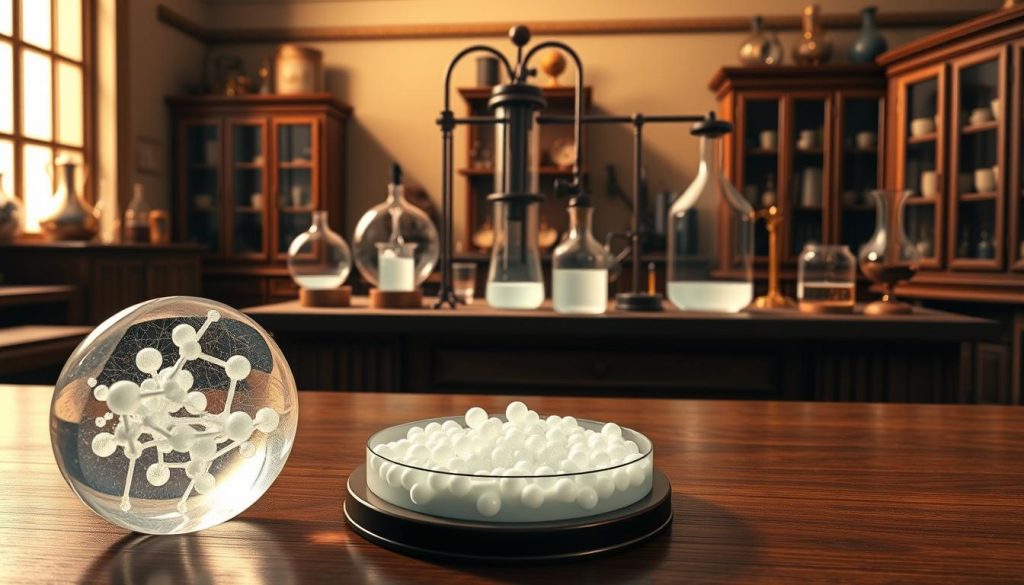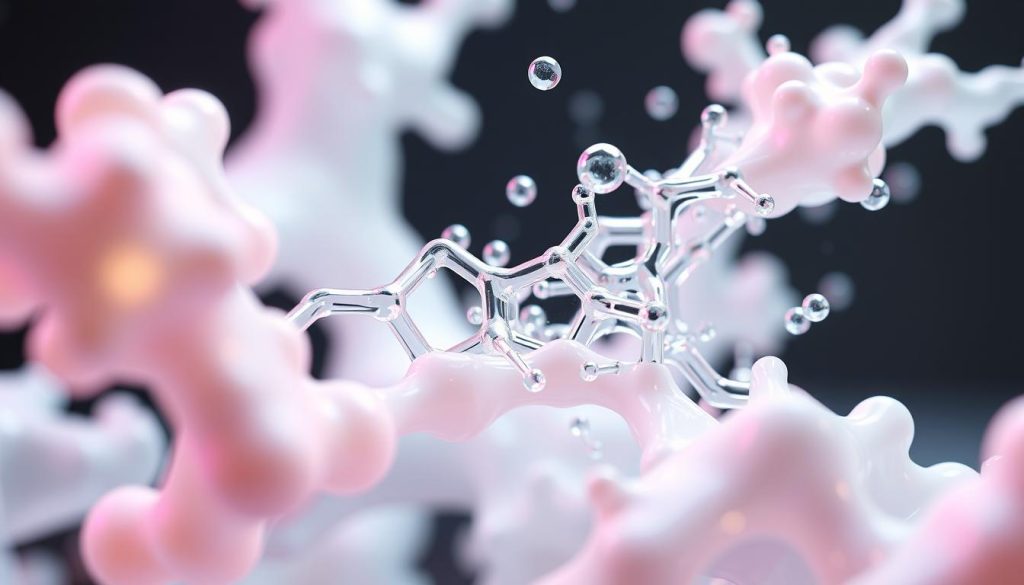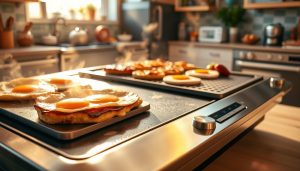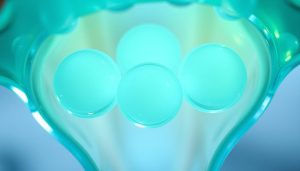Every year, over 1 million students in the U.S. discover how everyday ingredients can unlock fundamental chemistry concepts. One simple experiment using household items demonstrates how proteins transform into a moldable material resembling store-bought alternatives. This hands-on activity bridges the gap between theoretical science and tangible results.
When heated dairy mixes with an acidic solution, a chemical reaction occurs that changes molecular structures. The process separates casein proteins, creating curds that harden into durable forms. These natural polymers share properties with synthetic materials but form without industrial processes.
Educators favor this project for its ability to teach multiple concepts simultaneously. Learners explore acid-base interactions, protein denaturation, and sustainable material creation – all with tools found in most kitchens. The experiment’s versatility makes it adaptable for various age groups and learning environments.
Key Takeaways
- Common kitchen ingredients can demonstrate complex chemical processes
- Casein proteins form natural polymers when exposed to acids
- This experiment teaches multiple STEM concepts simultaneously
- Resulting materials showcase biodegradable alternatives to synthetics
- Hands-on learning enhances retention of scientific principles
Introduction to Milk Plastic and Its Chemistry
Long before synthetic options dominated manufacturing, artisans crafted elegant accessories from a surprising source – dairy. This biodegradable material, formally called casein plastic, reshaped early 20th-century design through its versatility and organic origins.

What Is Milk Plastic?
Casein plastic forms when proteins in dairy interact with acids. Unlike petroleum-based versions, this natural polymer develops through protein bonding rather than industrial synthesis. The resulting substance can be molded into intricate shapes while wet, hardening into durable forms that resist moisture.
Early manufacturers prized its marble-like patterns and ability to hold dyes. You’ll notice these traits in vintage buttons or jewelry boxes, where swirling colors mimic precious stones. Modern experiments skip toxic additives used historically, focusing on eco-friendly creation methods.
A Brief History of Casein Plastic
From 1900 to 1945, factories produced tons of this material for everyday items. Royalty even wore casein accessories – Queen Mary’s jeweled combs showcased its luxury potential. Art deco designs favored its smooth finish for fountain pens and mirror frames.
Industrial production involved formaldehyde washes to strengthen the protein matrix. Home experiments today simplify the process, using heat and vinegar instead. Though synthetic plastics eventually replaced casein due to lower costs, its legacy lives on in museum collections and sustainable science projects.
Why Vinegar + Milk = Plastic? – The Science Explained
Transforming everyday ingredients into durable materials isn’t magic—it’s chemistry in action. The interaction between dairy proteins and acidic solutions reveals how natural substances reorganize at the molecular level. Let’s examine the precise mechanisms behind this fascinating transformation.
Understanding Casein and Protein Denaturation
Milk contains clusters of casein molecules, a type of protein that acts as building blocks. Each individual unit (called casein) serves as a monomer. When heated, these structures unravel like twisted ropes. This process, known as denaturation, exposes hidden hydrophobic regions that naturally repel water.

How Acid and Heat Transform Milk Molecules
Adding an acidic solution introduces hydrogen ions that alter electrical charges on amino acids. This double punch of heat energy and acidic disruption forces proteins to rebond in new configurations. Clusters merge into polymer chains, creating a mesh-like network that solidifies as moisture evaporates.
Industrial methods use formaldehyde to strengthen these bonds permanently. Your kitchen experiment achieves similar results through temporary crosslinks. Both processes showcase how manipulating molecular interactions can yield materials with practical applications.
Materials and Techniques for Creating Casein Plastic
Successful kitchen experiments begin with proper preparation. Gather these common items to unlock molecular transformations through simple chemical processes. Precision in measurements and heating methods determines your project’s outcome.

Essential Supplies and Kitchen Tools
You’ll need 1 cup of 2% dairy and 4 tablespoons of white acidic solution. A microwave-safe container or saucepan works for heating – glass bowls prevent unwanted reactions. Keep measuring spoons, stirring utensils, and absorbent towels nearby.
Optional tools expand creative possibilities. Silicone molds shape ornaments, while food coloring adds vibrant patterns. For smoother textures, strain mixtures through fine mesh before molding. Always label containers to avoid cross-contamination.
Important Safety Tips
Heat dairy gradually to prevent scorching. Steam should rise before adding acidic components – never boil liquid directly. Use oven mitts when handling hot containers, and work on heat-resistant surfaces.
- Maintain 12-inch distance from microwave during heating cycles
- Wash hands immediately after handling curds
- Discard cracked or chipped glassware
Adult supervision proves crucial when working with temperatures exceeding 150°F. Proper ventilation reduces lingering odors during protein separation. Store finished pieces away from moisture to prevent degradation.
Step-by-Step Guide to Making Plastic from Milk and Vinegar
Creating your own biodegradable material starts with two simple ingredients found in any kitchen. This precise method transforms ordinary components into a durable substance through controlled chemical reactions.

Heating the Milk and Adding Vinegar
Heat 1 cup of dairy in a microwave-safe container for 90 seconds until steam rises. Stovetop users should warm it over medium heat until tiny bubbles form at the edges. Immediately stir in 4 tablespoons of acidic solution – the mixture will separate into solid clumps and cloudy liquid within 60 seconds.
Use a slotted spoon to transfer the rubbery mass into a strainer. Press gently to remove excess moisture, revealing a texture similar to fresh cheese. This dough-like substance contains bonded proteins ready for shaping.
Molding and Drying the Casein Plastic
Place the strained curds between folded paper towels to absorb residual liquid. Knead briefly until pliable, then press into silicone molds or cookie cutters. For free-form designs, sculpt by hand within 10 minutes before hardening begins.
- Position creations on fresh towels in a dust-free area
- Rotate pieces every 12 hours during drying
- Avoid touching surfaces for 48 hours
The material gains strength as moisture evaporates, becoming scratch-resistant within two days. Once fully cured, decorate with permanent markers for personalized designs.
Experiment Variations and Creative Enhancements
Science becomes art when you customize this kitchen experiment. Testing variables reveals how minor changes affect material properties while unlocking creative potential. Let’s explore methods to elevate both learning outcomes and visual appeal.
Exploring Different Milk Types and Vinegar Ratios
Fat content dramatically changes results. Skim versions produce brittle pieces, while whole dairy yields flexible sheets. Heavy cream creates glossy surfaces ideal for jewelry prototypes. Try these ratios:
- 1 tbsp acid per ½ cup low-fat options
- 2 tbsp acid per ½ cup whole versions
- 3 tbsp acid per ½ cup cream
Citrus juices work as acidic agents but require longer curing times. Lemon solutions create softer textures, while apple cider versions add amber tones.
Using Food Coloring and Custom Molds
Add 3 drops of food coloring before heating liquids for even distribution. Layer multiple hues in silicone molds to create marbled effects. Cookie cutters transform pliable curds into stars, hearts, or alphabet letters within minutes.
For advanced projects:
- Press dried flowers into surfaces before hardening
- Carve designs with toothpicks
- Dust edible glitter on wet forms
These modifications turn basic experiments into gallery-worthy creations while teaching color theory and material science principles.
Conclusion
This hands-on activity bridges centuries of scientific discovery through simple chemical interactions. Combining casein proteins with acidic solutions forms durable polymer chains, mirroring early manufacturing techniques. You’ll witness how natural materials transform into functional creations, linking historical practices with modern chemistry.
Following safety protocols ensures successful shaping of various forms during drying. Once mastered, this experiment becomes a gateway to exploring synthetic polymers and biodegradable alternatives. Young learners gain practical insights into molecular structures, preparing them for advanced studies in material science and sustainable design.



